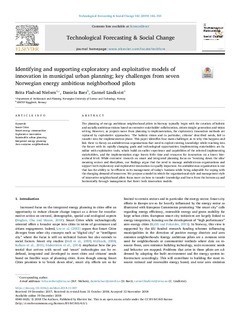| dc.contributor.author | Nielsen, Brita Fladvad | |
| dc.contributor.author | Baer, Daniela | |
| dc.contributor.author | Lindkvist, Carmel Margaret | |
| dc.date.accessioned | 2019-05-14T06:35:14Z | |
| dc.date.available | 2019-05-14T06:35:14Z | |
| dc.date.created | 2018-12-25T18:00:36Z | |
| dc.date.issued | 2018 | |
| dc.identifier.citation | Technology Forecasting and Social Change. 2018, 1-12. | nb_NO |
| dc.identifier.issn | 0040-1625 | |
| dc.identifier.uri | http://hdl.handle.net/11250/2597471 | |
| dc.description.abstract | The planning of energy ambitious neighborhood pilots in Norway typically begin with the creation of holistic and socially ambitious visions based on extensive stakeholder collaboration, citizen insight generation and vision setting. However, as projects move from planning to implementation, the exploratory innovation methods are replaced by exploitative approaches. ‘The holistic vision and in particular, citizens’ described needs, fail to transfer into the implementation phase. This paper identifies four main challenges as to why this happens and link these to theory on ambidextrous organizations that need to exploit existing knowledge while reaching into the future with its rapidly changing goals and technological opportunities. Implementing stakeholders are familiar with exploitative tools, which build on earlier experience and capabilities of the selected implementing stakeholders, and the implementation stage leaves little time and resources for innovation on a lower hierarchical level. While extensive research on smart and integrated planning focus on ‘breaking down the silos’ meaning sectors and disciplines, our findings argue that the need to manage ambidextrous organizations and support both exploratory and exploitative innovation is equally important. An ambidextrous organization is one that has the ability to be efficient in its management of today's business while being adaptable for coping with the changing demand of tomorrow. We propose a model in which the organizational style and management style of innovative neighborhood pilots focus more on how to transfer knowledge and learn from the bottom-up and horizontally through management that foster both innovation models. | nb_NO |
| dc.language.iso | eng | nb_NO |
| dc.publisher | Elsevier | nb_NO |
| dc.rights | Attribution-NonCommercial-NoDerivatives 4.0 Internasjonal | * |
| dc.rights.uri | http://creativecommons.org/licenses/by-nc-nd/4.0/deed.no | * |
| dc.title | Identifying and supporting exploratory and exploitative models of innovation in municipal urban planning; key challenges from seven Norwegian energy ambitious neighborhood pilots | nb_NO |
| dc.type | Journal article | nb_NO |
| dc.type | Peer reviewed | nb_NO |
| dc.description.version | publishedVersion | nb_NO |
| dc.source.pagenumber | 1-12 | nb_NO |
| dc.source.journal | Technology Forecasting and Social Change | nb_NO |
| dc.identifier.doi | 10.1016/j.techfore.2018.11.007 | |
| dc.identifier.cristin | 1647104 | |
| dc.relation.project | Norges forskningsråd: 255130/E20 | nb_NO |
| dc.relation.project | Norges forskningsråd: 257660 | nb_NO |
| dc.description.localcode | © 2018 The Authors. Published by Elsevier Inc. This is an open access article under the CC BY-NC-ND license (http://creativecommons.org/licenses/by-nc-nd/4.0/) | nb_NO |
| cristin.unitcode | 194,61,50,0 | |
| cristin.unitname | Institutt for arkitektur og planlegging | |
| cristin.ispublished | true | |
| cristin.fulltext | original | |
| cristin.qualitycode | 1 | |

